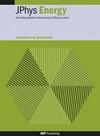通过操作中子断层扫描了解运行燃料电池中的水动力学:对不同流场设计的研究
IF 6.3
3区 材料科学
Q1 ENERGY & FUELS
引用次数: 0
摘要
水管理在确保聚合物电解质燃料电池(PEFC)的最佳性能方面发挥着关键作用,而流场设计则会影响电池平衡保持水合的能力,同时避免水浸和电池故障。这项研究利用我们的新型高速中子计算机断层扫描方法,加深了对不同 PEFC 流道设计(即单蛇形(SS)、双蛇形(DS)和平行)中水演化的理解。我们对之前报告的方法进行了改进,引入了连续的细胞旋转,在 300、400 和 500 mA cm-2 下保持 1 小时,每张断层图可显示 18 秒。我们对阴极、膜电极组件和阳极的水蒸发量进行了量化,并阐明了不同流道设计中水滴形成的关键机制。平行流场设计的水管理效果最差,在 400 mA cm-2 条件下 1 小时后,47% 的阴极流道被填满。这种严重的充水现象阻塞了反应物位点,导致电池性能不稳定,最终导致电池在较高电流密度下失效。SS 电池的水管理效果最好,在 500 mA cm-2 条件下 1 小时后,只有 11% 的阴极流道充满了水,而 DS 阴极流道则有 28% 充满了水。液滴行为的三维可视化和分析阐明了 SS 中的水 "蛞蝓 "是如何在气流中被清除的,而四个平行阴极流道中的三个则完全被水塞填满,阻塞了气流,加剧了电池淹没。这里获得的新见解有望扩展到新的流场设计和基于图像的模型,使用操作中子计算机断层扫描(operando neutron CT)被证明是一种强大的技术,可用于可视化和量化运行中的 PEFC 中的水管理,以及加深对不同流场类型中液滴行为的了解。本文章由计算机程序翻译,如有差异,请以英文原文为准。
Understanding water dynamics in operating fuel cells by operando neutron tomography: investigation of different flow field designs
Water management plays a key role in ensuring optimum polymer electrolyte fuel cell (PEFC) performance, and flow field design can influence the ability of a cell to balance maintaining hydration, whilst avoiding flooding and cell failure. This work deepens the understanding of water evolution in different PEFC flow channel designs, namely single serpentine (SS), double serpentine (DS) and parallel, using our novel high-speed neutron computed tomography method. We developed our previously-reported method by introducing continuous cell rotation, enabling 18 s per tomogram during 1 h holds at 300, 400 and 500 mA cm−2. The volume of water evolved in the cathode, membrane electrode assembly and anode was quantified, and key mechanisms for water droplet formation in the different flow channel designs were elucidated. The parallel flow field design had the poorest water management, with 47% of the cathode flow channel becoming filled after 1 h at 400 mA cm−2. This significant flooding blocked reactant sites and contributed to unstable cell performance and, ultimately, cell failure at higher current densities. The SS cell displayed the best water management, with only 11% of the cathode channel filled with water after 1 h at 500 mA cm−2, compared with 28% of the DS cathode channel. 3D visualisation and analysis of droplet behaviour elucidated how water ‘slugs’ in the SS were removed in the gas stream, whereas three of the four parallel cathode flow channels became entirely filled with water plugs, blocking gas flow and exacerbating cell flooding. The new insights gained here are expected to extend to novel flow field designs and image-based models, with the use of operando neutron CT demonstrated as a powerful technique for both visualising and quantifying water management in operating PEFCs, as well as deepening the knowledge of droplet behaviour in different flow field types.
求助全文
通过发布文献求助,成功后即可免费获取论文全文。
去求助
来源期刊

Journal of Physics-Energy
Multiple-
CiteScore
10.90
自引率
1.40%
发文量
58
期刊介绍:
The Journal of Physics-Energy is an interdisciplinary and fully open-access publication dedicated to setting the agenda for the identification and dissemination of the most exciting and significant advancements in all realms of energy-related research. Committed to the principles of open science, JPhys Energy is designed to maximize the exchange of knowledge between both established and emerging communities, thereby fostering a collaborative and inclusive environment for the advancement of energy research.
 求助内容:
求助内容: 应助结果提醒方式:
应助结果提醒方式:


